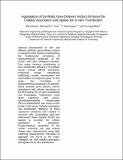| dc.contributor.author | Simeon, Fritz | |
| dc.contributor.author | Tam, Michael K.C. | |
| dc.contributor.author | Hatton, T. Alan | |
| dc.contributor.author | Too, Heng-Phon | |
| dc.date.accessioned | 2007-02-05T23:51:52Z | |
| dc.date.available | 2007-02-05T23:51:52Z | |
| dc.date.issued | 2007-01 | |
| dc.identifier.uri | http://hdl.handle.net/1721.1/35871 | |
| dc.description.abstract | Development of safe and efficient synthetic gene delivery vectors is hampered with limited understanding the fundamental correlation of physicochemical properties of the vectors with their biological activities. Five major barriers contributing to poor transfection efficiency of synthetic vectors include cellular association, endosomal escape, intracellular trafficking, nuclear translocation and transcription of exogenous genes. In this study, the correlation of physicochemical properties of polymer-based synthetic gene delivery vectors (polyplexes) with cellular association as the first barrier for in vitro transfection was investigated. Polyethylene oxide block copolymer with poly(2-(dimethylamino)ethyl methacryate) (PEO-b-pDMAEMA) was chosen as the model in this study. Cellular association and transfection efficiency of block copolymer complexes were studied in Neuro2A cells. Quantitative real time polymerase chain reaction (PCR) was applied to elucidate the cellular association of polyplexes. Physicochemical properties of the vectors including size and surface charge were characterized using light scattering measurements. Formation of aggregate was found as the major indication for high cellular association and uptake for in vitro transfection. | en |
| dc.description.sponsorship | Singapore-MIT Alliance (SMA) | en |
| dc.language.iso | en | en |
| dc.relation.ispartofseries | Chemical and Pharmaceutical Engineering (CPE) | en |
| dc.subject | PEO-b-pDMAEMA | en |
| dc.subject | DLS | en |
| dc.subject | Zeta Potential | en |
| dc.subject | Transfection | en |
| dc.subject | Quantitative Real Time PCR | en |
| dc.title | Aggregation of Synthetic Gene Delivery Vectors Enhance the Cellular Association and Uptake for in vitro Transfection | en |
| dc.type | Article | en |
